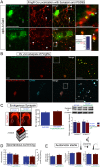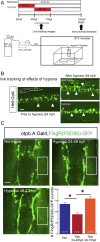Transgenic FingRs for Live Mapping of Synaptic Dynamics in Genetically-Defined Neurons
- PMID: 26728131
- PMCID: PMC4700522
- DOI: 10.1038/srep18734
Transgenic FingRs for Live Mapping of Synaptic Dynamics in Genetically-Defined Neurons
Abstract
Tools for genetically-determined visualization of synaptic circuits and interactions are necessary to build connectomics of the vertebrate brain and to screen synaptic properties in neurological disease models. Here we develop a transgenic FingR (fibronectin intrabodies generated by mRNA display) technology for monitoring synapses in live zebrafish. We demonstrate FingR labeling of defined excitatory and inhibitory synapses, and show FingR applicability for dissecting synapse dynamics in normal and disease states. Using our system we show that chronic hypoxia, associated with neurological defects in preterm birth, affects dopaminergic neuron synapse number depending on the developmental timing of hypoxia.
Figures




Similar articles
-
A Viral Toolbox of Genetically Encoded Fluorescent Synaptic Tags.iScience. 2020 Jul 24;23(7):101330. doi: 10.1016/j.isci.2020.101330. Epub 2020 Jun 30. iScience. 2020. PMID: 32674057 Free PMC article.
-
Directional Trans-Synaptic Labeling of Specific Neuronal Connections in Live Animals.Genetics. 2015 Jul;200(3):697-705. doi: 10.1534/genetics.115.177006. Epub 2015 Apr 27. Genetics. 2015. PMID: 25917682 Free PMC article.
-
A transgenic zebrafish model for in vivo long-term imaging of retinotectal synaptogenesis.Sci Rep. 2018 Sep 19;8(1):14077. doi: 10.1038/s41598-018-32409-y. Sci Rep. 2018. PMID: 30232367 Free PMC article.
-
Transgenic technology for visualization and manipulation of the neural circuits controlling behavior in zebrafish.Dev Growth Differ. 2008 Jun;50 Suppl 1:S167-75. doi: 10.1111/j.1440-169X.2008.01003.x. Epub 2008 Apr 22. Dev Growth Differ. 2008. PMID: 18430169 Review.
-
Fluorescence imaging of synapse formation and remodeling.Microscopy (Oxf). 2013 Feb;62(1):51-62. doi: 10.1093/jmicro/dfs083. Epub 2012 Dec 14. Microscopy (Oxf). 2013. PMID: 23243097 Review.
Cited by
-
Hypoxia and connectivity in the developing vertebrate nervous system.Dis Model Mech. 2018 Dec 12;11(12):dmm037127. doi: 10.1242/dmm.037127. Dis Model Mech. 2018. PMID: 30541748 Free PMC article. Review.
-
Towards a Comprehensive Optical Connectome at Single Synapse Resolution via Expansion Microscopy.Front Synaptic Neurosci. 2022 Jan 18;13:754814. doi: 10.3389/fnsyn.2021.754814. eCollection 2021. Front Synaptic Neurosci. 2022. PMID: 35115916 Free PMC article. Review.
-
Dopaminergic Co-Regulation of Locomotor Development and Motor Neuron Synaptogenesis is Uncoupled by Hypoxia in Zebrafish.eNeuro. 2020 Feb 27;7(1):ENEURO.0355-19.2020. doi: 10.1523/ENEURO.0355-19.2020. Print 2020 Jan/Feb. eNeuro. 2020. PMID: 32001551 Free PMC article.
-
Hypoplasia of dopaminergic neurons by hypoxia-induced neurotoxicity is associated with disrupted swimming development of larval zebrafish.Front Cell Neurosci. 2022 Sep 23;16:963037. doi: 10.3389/fncel.2022.963037. eCollection 2022. Front Cell Neurosci. 2022. PMID: 36212692 Free PMC article.
-
Controlling ion channel function with renewable recombinant antibodies.J Physiol. 2022 May;600(9):2023-2036. doi: 10.1113/JP282403. Epub 2022 Mar 17. J Physiol. 2022. PMID: 35238051 Free PMC article. Review.
References
Publication types
MeSH terms
Substances
Grants and funding
LinkOut - more resources
Full Text Sources
Other Literature Sources
Molecular Biology Databases
Research Materials

